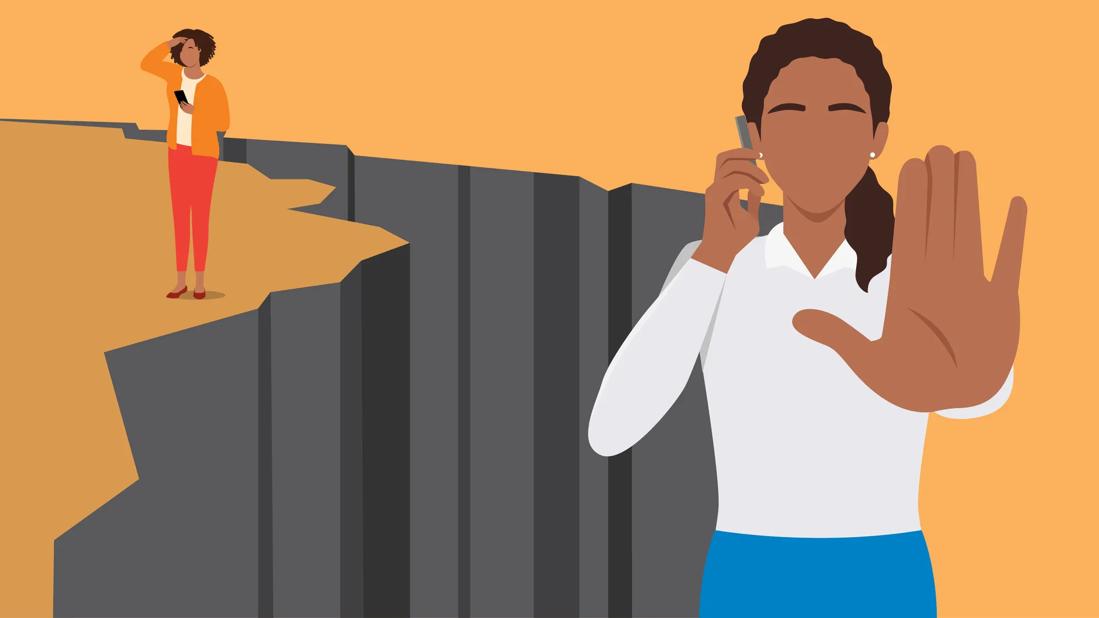Disconnecting from a loved one is a self-protective measure — and it’s usually a last resort

Going no-contact means you cut off all forms of communication with one or more members of your family. It’s usually a way to protect yourself or someone you’re responsible for, like a child or grandchild. Think of it as setting the ultimate boundary.
Advertisement
Cleveland Clinic is a non-profit academic medical center. Advertising on our site helps support our mission. We do not endorse non-Cleveland Clinic products or services. Policy
Going no-contact is often a last resort — a move you make when your family member is unwilling or unable to change their toxic behavior. In cases of abuse, going no-contact may be the only safe option.
Psychologist Chivonna Childs, PhD, explains the benefits and drawbacks of going no-contact and how to decide if it’s the right step for you.
The choice to go no-contact isn’t easy or fun. But it might be worth it. Ending your relationship with a toxic parent or family member may provide:
Advertisement
There are lots of good reasons to remove toxic family members from your life. But it isn’t a quick fix. And it can also come with consequences.
Perhaps the biggest downside of going no-contact? It isn’t always reversible.
“What if you change your mind later?” Dr. Childs poses. “If your loved one decides they want no contact, you have no choice but to respect their boundaries, like they respected yours.”
Going no-contact may be the right choice for you. But it requires thought and, sometimes, planning. Dr. Childs says you need to:
Advertisement
It’s also important to consider your age, Dr. Childs notes. If you’re a minor, everything’s a bit more difficult. If you’re considering going no-contact, she recommends having a conversation with a trusted adult — like a counselor, doctor or social worker — about the reasons why.
Here’s the thing about going no-contact: It only works if the person you’re cutting ties with respects your wishes.
“When you go no-contact, it’s usually because that person’s already crossed your boundaries,” Dr. Childs observes. “So, them not adhering to a no-contact request is something you need to be ready for.”
Dr. Childs advises that you keep records of any phone calls, trespassing or other unwanted attempts at contact. “That’s when you can take it to the courts,” she explains. “You can ask for a restraining order or protection order if necessary.”
Going no-contact isn’t easy. But sometimes, it’s the best option for everyone. If you’re considering estrangement but could use some help, a mental health provider can assist you in making a plan and support you throughout the process.
Advertisement
Learn more about our editorial process.
Advertisement

It can be harder to let go when you’ve invested time, energy and emotions — but it might be the healthier choice long term

Attachment theory suggests that your earliest relationships shape connections throughout your life

Love languages are defined by the way you prefer to give and receive affection

There are many different ways to love someone and yourself

If you find yourself obsessing over rejection or a one-sided relationship, you’re likely stuck in limerence

One is obsessive with infatuation, while the other involves equal parts commitment, intimacy and passion

We can carry the experiences from previous generations, like family baggage and trauma — but healing is possible

Pointing out how their behavior makes you feel and giving them projects to own can help you both

Start having sex about 72 hours before ovulation, then at least every other day during your fertile window

Attachment theory suggests that your earliest relationships shape connections throughout your life

It isn’t a recognized mental health disorder, but research shows that problematic social media use can negatively affect your mental health, self-esteem and sleep